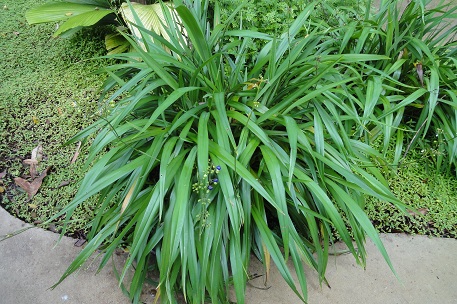Local Name: Setanggak
Scientific Name: Dianella ensifolia
Common Name: Flax Lilies
Family: Asphodelaceae
Description:
Being an evergreen and perennial herb, it has grass-like blades growing from rhizomes which are usually white. The plant has brown fibrous roots with a particular smell. It is able to spread and form a huge clumps and reach up to 1.5m tall (Useful Tropical Plants Database, 2018). The leaves can grow up to 50cm long with margin and midrib narrowly winged and small, prickly tip. Its basal part is flattened like a pseudopetiole. Inflorescence is lax panicle-like and much taller than the leaves. Tepals are around 5-7 mm and in pale mauve-blue colour. The subspherical fruit can grow up to 8 mm in diameter and has a glossy blue skin (Hyde et al., 2018).
Dianella ensifolia is a rhizomatous herb, 0.6-1(-2) m tall, with compressed stems, rigid and unbranched. The rhizomes are branched, white, measuring 6-10 mm thick, with scales 2-8 cm long, with fibrous roots, long, profusely branched, with a particular smell and brown.
The leaves are rosulate at the base, distichous on stem, narrowly elliptical to narrowly lance-shaped, measuring 30-60 cm x 2-3 cm, rigid, with keeled base, compressed, with sheathing, acute at apex, with rough margins and parallel-veined.
The inflorescence is a terminal, loosely cymose panicle, and measures 30-60 cm long exceeding the leaves. The flowers are bisexual, actinomorphic, with pedicel 6-12 mm long, jointed just beneath the flower. The perianth segments are free in 2 groups of 3 that are subequal, narrowly ovate, measuring 7-8 mm long, shortly apiculate, pale purplish-blue but sometimes white or yellowish.
The fruit is a fleshy berry, measuring 9-15 mm in diametre, blue-purple and shiny when ripens. It is 3-4-seeded. The seed is ovoid, 5 mm long, shortly beaked, smooth, black and shiny.
Plant Part Used: Root
Uses: Redness, swelling and rashes or itching in the breast
Method of preparation: Boiling
Ways of administration: Oral, 3 times per day
References:
Hyde, M.A., Wursten, B.T., Ballings, P. & Coates Palgrave, M. (2018). Flora of Zimbabwe: Species information: Dianella ensifolia.
https://www.zimbabweflora.co.zw/speciesdata/species.php?species_id=113690, retrieved 14 May 2018
http://tropical.theferns.info/viewtropical.php?id=Dianella+ensifolia
http://tropical.theferns.info/viewtropical.php?id=Dianella+ensifolia




